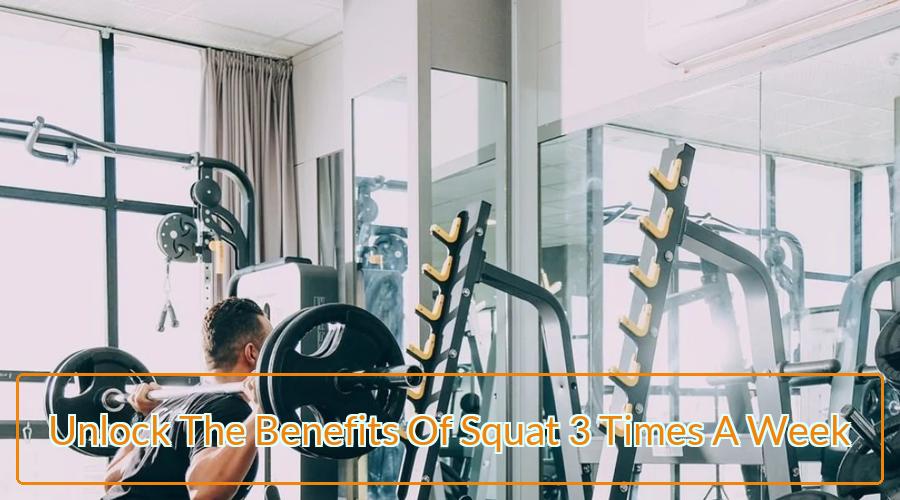
Squatting three times a week is a great way to increase lower body strength and improve overall fitness. Not only does it strengthen your legs, hips, glutes and spine, but it also increases flexibility and balance. Squatting can be done with just your body weight or dumbbells for an added challenge. However you choose to do them, here are the benefits of squatting three times a week that you can expect to reap.
Regularly completing squats will help build muscle mass and strength in the lower body muscles, leading to better performance during other exercises and sports activities. Squats also help develop good posture by strengthening the back muscles; this helps reduce fatigue when standing for long periods of time as well as improve overall posture throughout the day.
Maximize Your Fitness with Weekly Squats
Squats are an essential part of any fitness routine. When done correctly, these powerful exercises can have a profound effect on your overall physical health and wellbeing. Incorporating squats into your weekly routine is a great way to maximize your fitness goals and take your workouts to the next level.

The benefits of weekly squats are numerous. Squats help improve balance, mobility and flexibility while also strengthening muscles in your lower body, core and back. They also help by burning excess fat, building lean muscle mass, increasing metabolism and improving coordination.
Furthermore, incorporating regular squatting into your week will result in improved posture that can reduce back pain while enhancing muscular definition in the thighs, glutes and abs. To maximize the effects of each squat session it’s important to use proper form throughout each exercise.
Boost Your Wellbeing with Three Simple Squats a Week
Squats are one of the most basic and beneficial exercises that anyone can do. The simple movement targets both the lower body and core, building strength in key areas. But you don’t have to be an athlete or a gym rat to reap the rewards – just three squats per week can make a huge difference in your overall well being.
It’s easy to add squats into your regular routine; all you need is a few minutes and some space at home. As part of their weekly exercise plan, many people choose to do three sets of 10-15 squats each day – but even if you only do one set, that already goes a long way towards improving your posture, balance, flexibility and mobility. Plus, it helps engage your core muscles which in turn strengthens your back and improves overall stability during other activities like running or playing sports.
Gain Long Lasting Benefits from Just Three Squats
Squats are one of the most popular exercises used by people in almost every fitness program. While they often seem simple, performing squats correctly can help you achieve long-lasting benefits. With just three squats a day, it is possible to drastically improve your physical health and overall well-being.

A proper squat requires that you keep your back straight, chest out, and toes pointed forward while lowering yourself down until your thighs are parallel to the ground. This movement engages multiple muscles throughout the body and increases strength and flexibility in several areas.
Additionally, squats can help strengthen bones by increasing bone density, as well as boosting energy levels due to increased blood circulation during exercise. Regularly completing three squats per day can help you become more physically fit with improved posture and balance.
Three Squats to Ignite your Fitness Goals
The start of any fitness journey is daunting, but it doesn’t have to be. Squats are a simple yet effective exercise that can help you build strength and ignite your fitness goals. They target the major muscles in your legs, glutes, and core; all important components for overall health and fitness. With variations for all skill levels, here are three squats to get you started on your journey today!
The first squat variation is a bodyweight squat. This exercise requires no equipment and is great for beginners as it works on building strength while also teaching proper form. To do this, stand with feet shoulder-width apart and lower your hips down as if sitting in an imaginary chair behind you without rounding the back or letting the knees go past the toes. Hold the position at the bottom of the squat before standing up again to complete one repetition.
Transform Your Body in 30 Days With Squats
Squats are one of the most effective exercises for transforming your body in just 30 days. Not only do squats work multiple muscles at once, but they also help to build strength and endurance. If you’re looking for an exercise that will have a huge payoff in just one month, squats are the way to go!
Incorporating squats into your daily routine can maximize results. Start by doing three sets of 10-15 reps each day with proper form and technique. As your strength increases, you can increase the weight or add more repetitions as desired. Incorporate other variations like front squats and sumo squats to target different muscle groups and switch up your workouts. You should also focus on good nutrition and plenty of rest in order to get the best results from squatting within 30 days.
The Power of Squatting: Benefits Beyond the Booty
Squatting is an exercise that has various benefits and can be used to build strength, stability, and power. It’s an integral part of any fitness regimen for those looking to improve their physical health. But squatting offers many other benefits beyond just building muscle. Squatting has the power to influence multiple areas of life, whether it’s improving posture, aiding in weight loss goals, or boosting overall wellbeing.
The benefits of squatting are numerous; it helps to strengthen your legs and core muscles while at the same time improving flexibility. This can lead to better posture as well as improved balance and stability – both aspects which will come in handy in everyday life activities such as walking up stairs or reaching down for something on the ground.
Squat Three Times A Week and Feel Amazing
Squats are a great exercise for your overall health, as they build strength, improve flexibility and burn calories. Regularly doing squats will help you stay fit and toned while giving you more energy throughout the day.

Performing three sets of squats weekly can benefit your body in many ways. You will start to notice an increase in muscular endurance, which allows you to perform activities with ease and less fatigue. Additionally, squatting helps strengthen bones by increasing their density levels, making them stronger over time. Improving balance is another advantage of doing this exercise regularly – it will help you move better and prevent falls or injuries due to poor posture or instability.
What are the benefits of squatting?
Squatting is a form of exercise that has been popular for centuries and is used to build muscular strength and endurance. Squatting can help improve your overall fitness, as well as tone your muscles and help you maintain good posture. In addition, squatting offers several other benefits, including improved balance and flexibility, increased muscle mass and even enhanced mental health.
How often should I squat?
Squatting is an essential exercise for any fitness enthusiast, as it works a variety of muscle groups and helps to build strength and stability. It is important to ensure you are squatting with the correct technique and frequency in order to get the most out of your workout. This article will provide information on how often you should be squatting in order to improve your performance and reach your fitness goals.
What are the risks of squatting?
Squatting is a form of housing occupation, whereby an individual resides in a property without the formal permission or legal right to do so. It is often seen as a last resort for those unable to access or afford traditional housing options, and while it may offer certain advantages, there are also significant risks associated with squatting. This article aims to explore the potential risks that squatters can face when occupying a property without authorisation.